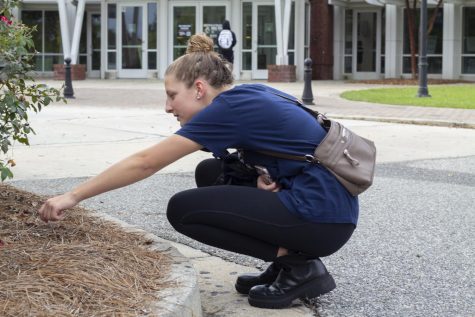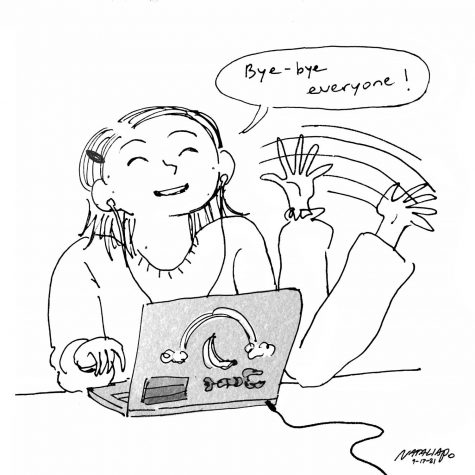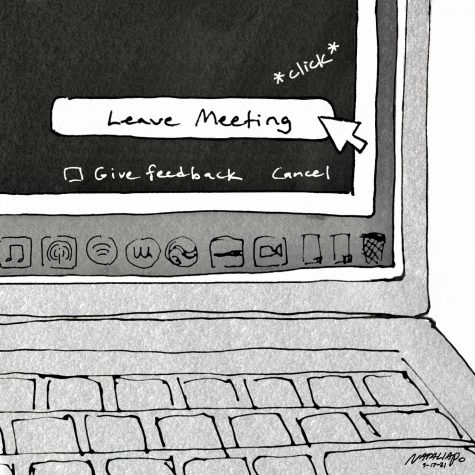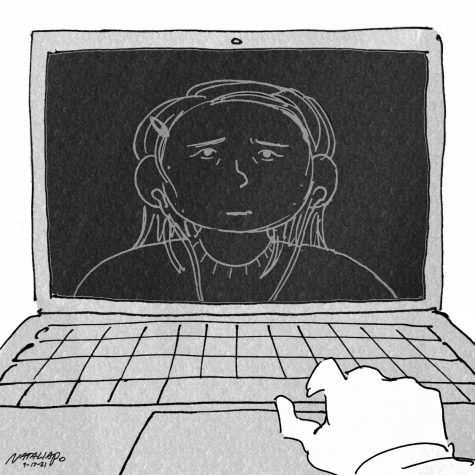
Evelyn Spear

The post Daily Photo (09.20.2021) appeared first on The George-Anne Media Group.
Posted on 20 September 2021.


The post Daily Photo (09.20.2021) appeared first on The George-Anne Media Group.
Posted in NewsComments Off on Daily Photo (09.20.2021)
Posted on 20 September 2021.
College is a time in many students’ lives where they first take an interest in maintaining an informed citizenry and staying up to date with current events. Going back as far as the 1960s, when anti-Vietnam War protests were spearheaded by university students, college remains a time for familiarizing yourself with the world’s latest affairs.
Posted in NewsComments Off on McKissick: Stop getting your news from social media
Posted on 20 September 2021.
At the close of every summer, there seems to be a frantic, retrospective search for the music that defined the season. In honor of this tradition, I’d like to take a moment to draw attention to an album that, thus far, has been subject to insufficient analysis. Solar Power is New Zealand singer-songwriter Lorde’s third studio album — and her most understated yet. In a departure from her previous albums Pure Heroine and Melodrama, which tremble from the emotional power of their raw piano and vocal work, Solar Power is a sun-soaked and self-reflective journey. Lorde is so dreamlike here, in fact, that the psychedelic tone of the songs very nearly obscures the bitterness of their lyrics. In the first track, titled “The Path,” Lorde sings:
Now, if you’re looking for a savior
Well that’s not me
And if you need someone to take your pain for you?
Well that’s not me
It’s sung very gently, but the message couldn’t be any more clear: It’s a plea for boundaries. Lorde is asking for a greater degree of separation between herself and her audience’s expectations — something that’s near unattainable for a woman in the performance industry.
Lorde wasn’t the only female artist dropping new music this summer, nor the only one using that music to send messages about her relationship with the public. In July, Lizzo released her single “Rumors” featuring Cardi B. The song, brassy and full of good-humored wit, is ridiculously catchy. However, just like in “The Path,” there’s a bite to its clever lyricism. Lizzo has spoken repeatedly about her experiences with sexism, racism and fatphobia over social media, and the song incorporates her frustration into the melody: They say I should watch the shit I post, oh goddamn / They say I’m turning big girls into hoes, oh goddamn. The “they” she refers to repeatedly throughout the track morphs from one nebulous entity to another. “They” refers to not just the bureaucratic forces of industry and the online haters, but also the larger and less defined sense Lizzo has of being perceived by all of her listeners. Without ever using the term, she’s referring to the parasocial relationships that have defined her career.
A parasocial interaction is defined as a “psychological relationship experienced by members of an audience in their mediated encounters with certain performers in the mass media.” This relationship between consumer and creator is characterized by its one-sidedness: an imagined sense of closeness that we, as an audience, have with celebrities who have never and will never know us.
What is becoming increasingly clear, in the music industry in particular, is that parasocialism is a woman’s game. Try to think of the defining fan bases of the American music scene over the past 20 years. Beyoncé’s Beyhive, Nicki Minaj’s Barbz, Lady Gaga’s Little Monsters, Ariana Grande’s Arianators and Taylor Swift’s Swifties all come to mind — all are dedicated to female artists. These fandoms are among the most organized, intense and cohesive in the industry. It’s that cohesion that gives them notoriety as well as power. In exchange for their Spotify streams, ticket purchases and unyielding devotion, fans ask for not only content but also the entirety of their idols’ selves. Parasocial relationships are fascinating because they seem, on the surface, to be mutually beneficial; they disguise their deep imbalances as something intimate. Questions of privacy, amenability and commodification — the dynamics that define an artist’s performative experience — have profound parallels to the similarly performative dynamics that everyday women live out in their social and professional lives.
This idea that women be appealing, malleable and constantly available is applied literally when the woman in question is a global superstar — and often with devastating consequences (think of female celebrities from the 2000s, such as Britney Spears or Lindsay Lohan). However, in the past decade, the existence of social media has heightened both the visibility of artists and the false sense of intimacy perceived by their listeners. And with this shift, feelings of entitlement to these women are growing, born from devotion to beloved stars. For instance, Lizzo’s body has been co-opted as an object of both adoration and vitriol to the point where she cannot post a TikTok of her daily routine without feeding into one narrative or another.
That’s not to say that fans don’t have expectations of male artists as well. But these expectations are typically limited to the more overtly professional aspects of their careers. For instance, there were complaints over Kanye West’s delay in releasing his album “Donda” — but not over his smoothie cleanse or whether he has contributed sufficiently to climate activism. “Artists” are allowed their eccentricities, solitude and degrees of separation from their fans while “performers” are not. And when the time comes to make a distinction between the two, we still subconsciously expect women to perform for us.
Lizzo and Lorde’s new releases are notable because they don’t just suffer under the weight of these pre-written stories, they give them a name, even if parenthetically and with the good cheer of any hit single. But just that act of acknowledgement calls forward a complicated legacy: one of commodification and expectations of women as subjects for projection. These are issues that have been dissected for decades by feminist thinkers from Butler to Beauvoir, but now they’ve permeated one place we can’t ignore: the Billboard Top 100. Rather than capturing the perfect beats for a rooftop party or a beach trip, this summer’s most impactful music instead provided us with an opportunity to reflect on what it means to love and engage with the women behind the play button.
Alissa Simon ’25 can be reached at alissa_simon@brown.edu. Please send responses to this opinion to letters@browndailyherald.com and other op-eds to opinions@browndailyherald.com.
Posted in NewsComments Off on Simon ’25: We’re failing our female artists
Posted on 20 September 2021.
We’ve officially survived syllabus week. Now we’ll do all this over again–for the next 14-something weeks until winter break. Get through the second week of school with our A&E writers’ favorite picks of the week.
“Like, life’s so fun, life’s so fun”:
The three-piece pop group, MUNA, recently opened for Phoebe Bridgers’ Minneapolis concert, and their stage presence was enough to get all the eyeliner-clad, platform shoe-wearing girlies jumping. They recently released their single “Silk Chiffon,” featuring Bridgers, and the single has an up-beat tempo with cutesy lyrics about falling in love with a pretty girl. Other effervescent songs performed at the concert include “Stayaway,” “Number One Fan” and “I Know A Place.” -Nina Raemont
Lorde breaks the ice:
Lorde recently covered “Break the Ice” by Britney Spears for a Vogue video exclusive in an effort to promote Solar Power. Although Lorde’s toned-down interpretation pays proper respect to the princess of pop, her effort simply doesn’t reach the same ecstatic height. With contributions from Keri Hilson and Danja, two late ‘00s dance-pop fixtures, the original single was featured on Britney’s 2007 album, Blackout, and failed to crack the Top 40 charts. Since then, it’s achieved cult status as one of the star’s most underrated songs. If you’re looking for a way to celebrate Jamie Spears’ lawyers filing to end his daughter’s conservatorship, be sure to revisit “Break the Ice.” -James Schaak
A sundae for your weekday:
Salty-sweet, crunchy and just the right amount of chewy — Milkjam Creamery’s Kunafa sundae packs a mean punch for a cool $10. Inspired by the beloved Middleastern dessert, the sundae base is a sweet cheese ice cream topped with pistachios, rose petals and shredded phyllo dough. It’s a classic example of Milkjam doing what Milkjam does best:; taking something we all love, spinning it on its head and delivering an end product that’ll be on your mind for days after. -Sophia Zimmerman
Food for your soul:
Golden Thyme Coffee & Cafe is a Black-owned restaurant that celebrated their 20th anniversary on September 11. Located in the historic Rondo neighborhood, Golden Thyme hosted their annual Jazz Fest, a festival that celebrates Black unity in St. Paul through music and culture, on their anniversary. The event’s musical scene consisted of live performances from local, regional and national jazz musicians. The main food option was soul food, featuring baked and fried chicken, catfish, fries, collard greens, baked macaroni and cornbread. Locals from the Selby neighborhood catered the food. -Jarrett George-Ballard
Posted in NewsComments Off on MUNA, new Milkjam flavors and food for the soul
Posted on 20 September 2021.


Gerald Sastra/ The Cougar
This semester UH announced a soft opening for the first few weeks of school in response to the COVID-19 pandemic, which some students said increased their wellness and eased some of their stress.
As a result, these students have found ways to help their mental wellbeing since the transition from online to back to in-person this year.
“The soft opening has allowed for more flexibility for students to manage their school work, class schedule and extracurriculars,” said junior accounting Maisha Walker. “It has been a way to ease into the school year given the dramatic change and stress everybody has been through during the past year and a half.”
The discourse within Texas regarding masks and the COVID-19 vaccine raised concern for some UH community members on how the rest of the school year will go once all classes are at full density.
“I feel the soft opening eased a lot of stress for people who are worried about how Harris County is doing with case numbers right now,” said sociology senior Liz Nguyen. “It feels really counterproductive to take that option away now.”
Reuben Parrish, the director of UH Wellness, shared five tips on handling the semester; trying to get 8-10 hours of sleep, being physically active, meditating, getting physical checkups at the doctor’s office and focusing on your nutrition.
“Being mindful and taking time out to breathe, especially since the semester has been overwhelming because of COVID,” Parrish said.
The UH Wellness staff hosts free weekly meditation sessions on Thursdays between 12:15 p.m. and 12:45 p.m., where students and staff can sit quietly and reflect. Their goal is to provide a safe space for mental and emotional development.
With the uncertainty of the pandemic and UH welcoming back students this fall, there is a greater push for emotional support during these times.
“We want to provide all these services, programs and outreach events that allow students to partake and learn about how they can improve their wellbeing,” Parrish said.
news@thedailycougar.com
—
“UH soft opening ‘eased a lot of stress,’ some students say” was originally posted on The Cougar
Posted in NewsComments Off on UH soft opening ‘eased a lot of stress,’ some students say
Posted on 20 September 2021.
Fowler’s new album “The Grief We Gave Our Mother” has strong folk ballads and catchy acoustic sounds.
Posted in NewsComments Off on REVIEW: Matthew Fowler opens at Club Passim
Posted on 20 September 2021.
After a thirty-year teaching career, associate art teaching lecture professor Sandra Brunvand is bidding the University of Utah farewell with her studio exhibition “It’s Not Always Black and White.”
“It’s a real honor to be in that space — it’s the heart of that building,” Brunvand says on her exhibition. While the Gittins Gallery is the Department of Art and Art History’s heart, “It’s Not Always Black and White” is an extension of Brunvand’s body, both physically and mentally.
The exhibition is spatially and chronologically circulatory, as Brunvand’s early works in color sit like lungs at the core of the exhibition while later works in black and white form a ribcage on the outer edges. The breadth of artworks is a mirror to Brunvand’s personality and essence, drawing on important people and objects from Bruvand’s life.
The exhibition features Brunvand’s earliest work, a drawing of a dog, with the topmost right corner reading “Sandy 4 Years” in her father’s penmanship while sitting in a frame constructed by her husband. Intimate details such as these truly add to the exhibition’s personal nature via the connection to Brunvand herself.
The use of wax provides yet another congruence to Brunvand’s body as several artworks involve detritus embedded in wax. “I have really bad arthritis, I started using wax quite some time ago so that healing property is what I wanted to go into my artwork,” says Brunvand.
In addition to wax materials, Brunvand also uses some of her dog’s hair as well as gifted player piano scrolls within her pieces. “I’ve always thought there was a lot of my soul in there, my personality.”
In an artistic transference from physically taxing works in color, Brunvand shifts to a limited black and white palate with ecotone landscapes. “My feet just wanted to keep hiking [in Utah],” she said. “I loved the landscape … even when I’m painting abstract work I always see a landscape.”
These representational landscapes provide a biodiverse area of overlap that serves for unlimited growth, beckoning the mantra “It’s Not Always Black and White.” For Brunvand this is certainly true, as the representational landscapes were the shift into Brunvand’s mental space in current events and away from manual works due to limitations from the same body.
The landscapes are specifically curated to words of empowering women, retracted Trump tweets, police messaging, and current event headlines that have been manually printed with a typewriter. “Not only did the words activate the space, but the space activated the words,” said Brunvand, as she chose the landscapes as devices paired to current event narratives that sparked her inspiration.
To Brunvand, “that series was a form of self-care,” and again viewers recognize Brunvand’s mental body within the exhibition. When asked what she wishes viewers to get out of viewing the exhibition, Brunvand says “pay attention to the headlines … how do we self-care when times are difficult?”.
“I want to linger longer in everything,” said Brunvand on her bittersweet farewell from teaching. “I’m certainly heading in a new way.”
“It’s Not Always Black and White” is on view in the Gittins Gallery from Sept. 7-17, 2021.
a.greig@dailyutahchronicle.com
The post Space and Body in Sandra Brunvand’s ‘It’s Not Always Black and White’ appeared first on The Daily Utah Chronicle.
Posted in NewsComments Off on Space and Body in Sandra Brunvand’s ‘It’s Not Always Black and White’
Posted on 20 September 2021.
The Daily Trojan features Classified advertising in each day’s edition. Here you can read, search, and even print out each day’s edition of the Classifieds.
Click the icon to download the PDF of today’s Classifieds:
To place an ad, please contact an ad representative:
(213) 740-2707
USC Student Publications Student Union – Room 400
Los Angeles, CA 90089-0895
The post Classifieds – September 20, 2021 appeared first on Daily Trojan.
Posted in NewsComments Off on Classifieds – September 20, 2021
Posted on 20 September 2021.



Posted in NewsComments Off on Editorial cartoon: Masking Up
Posted on 20 September 2021.
This review contains spoilers.
Don’t know about “Shang-Chi: The Legend of the Ten Rings”? You’re not at fault — Marvel is. Canadian actor Simu Liu promoted the film more than Marvel on social media. Although hype on social media for the new film was minimal, it ranks first in the box office in typical Marvel fashion.
“The Legend of the Ten Rings” begins by setting the stage for our hero. The titular ten rings grant their user immortality and power rivaling the Gods. With them in his arsenal, Xu Wenmu (Tony Leung) alters the course of Earth’s history for thousands of years.
In 1996, he attempts to travel to Ta Lo (a secret village), one of the few places he has yet to set foot. However, he is stopped by Ying Li (Emory’s very own Fala Chen(05B)), guardian of Ta Lo, and after a fight, the pair fall in love. They have two children: Shang-Chi and Xialing (Meng’er Zhang).
In present-day San Francisco: Shang-Chi and his longtime friend Katy (Awkwafina) work as valets. Their adventure begins when assassins are sent to retrieve an amulet Shang-Chi was gifted by his mother before she died. Shang-Chi then sets out for Macau, China, looking for his sister and the reason why the amulet is so sought after.
The movie departs from Marvel’s outdated, racist comic series, “Shang-Chi: Master of Kung Fu.” The comics from the 1970s featured broken English and negative, racist tropes that discriminated against Asians in order to paint a stereotypical, monolithic caricature of many cultures.
We learn that one of the main villains is Shang-Chi’s own father, Xu Wenmu. In the comics, his father is Fu Manchu, a racist anti-asian stereotype. Though the comics and Fu Manchu had been forgotten, the history behind them resurfaced in 2018.
Director Destin Daniel Cretton opted for slight changes to the character of Shang-Chi’s father that ultimately made all the difference. Cretton changed the character’s name to Xu Wenmu and cast Tony Leung, a prominent Hong Kong actor in the role. These subtle yet important changes allow Xu Wenmu to become a character who elicits sympathy rather than outrage.
The film subverts typical Hollywood stereotypes toward Asians, exploring Chinese values and never aiming offensive jokes at the characters. Characters are no longer merely “quiet and smart Asians” but real people with their own flaws: both Shang-Chi and Katy suffer from not wanting to grow up, and while Katy’s mother and friends scold them about it, they never joke about the “tiger mom” concept. Shang-Chi’s sister is strong and independent, but is never sexualized to the point of being a “dragon lady.”
The film also addresses the topics of immigration and identity. Katy must find herself and what she wants to do when she is confused about her own identity, while Shang-Chi must face his past as a trained killer that clashes with his new life in the United States.

Shang-Chi (Simu Liu) ‘Shang Chi and the Legend of the Ten Rings.’ (Marvel Studios)
Despite all of these high points, “Shang-Chi” struggles with pacing. A film in the Avengers franchise requires little or no backstory as pillars of pop culture. “Shang-Chi” on the other hand, suffers from the long introductory sequence to set up the plot. The pacing also fell flat during the final confrontation between Shang-Chi and his father. It felt like different portions of the fight were developed at different stages of the movie’s production, giving the viewer whiplash. Even so, this problem is minor and pales in comparison to the beauty of the final trial Shang-Chi endures.
The finale of the film is a grand battle of epic proportions. The music, setting and ambience keep your eyes glued to the screen, and no words can describe how jaw-dropping it is. Viewers didn’t cheer when Shang-Chi defeated the villain — they were simply left speechless. They did, however, cheer for Katy when she landed a crucial hit on the villain that turned the tides of battle.The other fight sequences are similarly well-choreographed. Cretton offsets heart-wrenching moments with Katy’s comedic timing and Shang-Chi’s thrilling heroics.
With a soundtrack comprised of popular artists — most notably 88rising, a label that features primarily Asian and Asian American talent — “Shang-Chi: The Legend of the Ten Rings,” is an action packed introduction to Marvel’s newest hero who not only fights villains, but also racial stereotypes.
The post “Shang-Chi” fights villains and racial stereotypes appeared first on The Emory Wheel.
Posted in NewsComments Off on “Shang-Chi” fights villains and racial stereotypes